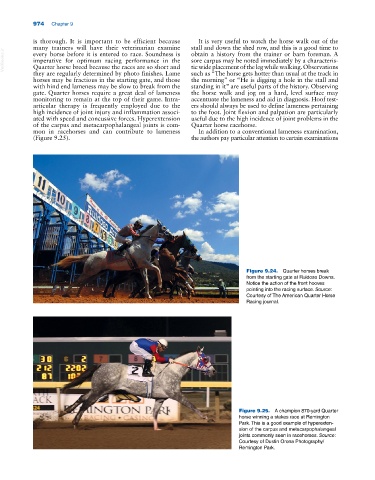Page 1008 - Adams and Stashak's Lameness in Horses, 7th Edition
P. 1008
974 Chapter 9
is thorough. It is important to be efficient because It is very useful to watch the horse walk out of the
many trainers will have their veterinarian examine stall and down the shed row, and this is a good time to
VetBooks.ir imperative for optimum racing performance in the sore carpus may be noted immediately by a characteris
obtain a history from the trainer or barn foreman. A
every horse before it is entered to race. Soundness is
tic wide placement of the leg while walking. Observations
Quarter horse breed because the races are so short and
they are regularly determined by photo finishes. Lame such as “The horse gets hotter than usual at the track in
horses may be fractious in the starting gate, and those the morning” or “He is digging a hole in the stall and
with hind end lameness may be slow to break from the standing in it” are useful parts of the history. Observing
gate. Quarter horses require a great deal of lameness the horse walk and jog on a hard, level surface may
monitoring to remain at the top of their game. Intra‐ accentuate the lameness and aid in diagnosis. Hoof test
articular therapy is frequently employed due to the ers should always be used to define lameness pertaining
high incidence of joint injury and inflammation associ to the foot. Joint flexion and palpation are particularly
ated with speed and concussive forces. Hyperextension useful due to the high incidence of joint problems in the
of the carpus and metacarpophalangeal joints is com Quarter horse racehorse.
mon in racehorses and can contribute to lameness In addition to a conventional lameness examination,
(Figure 9.25). the authors pay particular attention to certain examinations
Figure 9.24. Quarter horses break
from the starting gate at Ruidoso Downs.
Notice the action of the front hooves
pointing into the racing surface. Source:
Courtesy of The American Quarter Horse
Racing journal.
Figure 9.25. A champion 870‐yard Quarter
horse winning a stakes race at Remington
Park. This is a good example of hyperexten-
sion of the carpus and metacarpophalangeal
joints commonly seen in racehorses. Source:
Courtesy of Dustin Orona Photography/
Remington Park.

